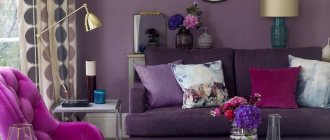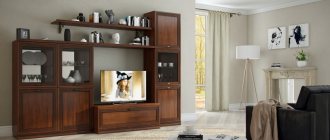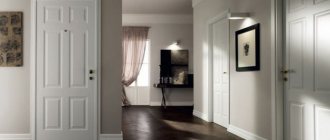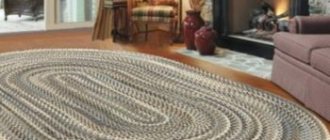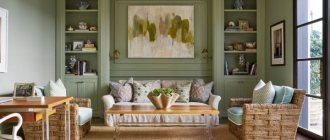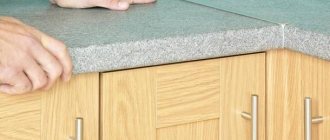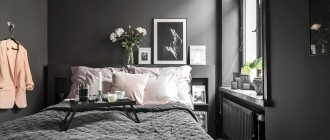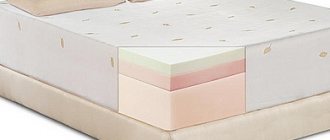A cornice is a decorative element that holds curtains and curtains. The accessory consists of guides (crossbars) and brackets with fasteners, complemented by hangers (for example, rings, hooks) and decorative elements. A simple device has several types of designs and many design methods.
Curtains with lambrequins Source www.gorizont.com.ua
Several short curtain rods Source www.pinterest.com
Cornice for heavy curtains Source www.houzz.ru
Types of curtains for curtains
If he doesn’t have any big problems with curtains, then the choice of curtains often doesn’t just confuse him, but makes him think.
Of course, our contemporary, before going to the store, will review on the Internet many different photos of curtains for curtains, which will undoubtedly help him with choosing the appearance of these products.
However, in addition to their appearance, curtains also differ in their functional features. Although these differences are not great, they still need to be taken into account.
Baguette, rail products
Rail consoles look like structures made of metal or plastic. The products are distinguished by the presence of rollers with hooks that move along special grooves. To ensure that the fastening elements do not fall, they are secured at both edges with reliable plugs.
Baguette cornices are a decorated strip for mounting curtains that covers fastening elements. Such products are ideal for using hidden lighting. The plank is decorated with elements that echo the overall design.
Ceiling mount cornice
Based on their mounting location, they are divided into ceiling and wall mounted. Ceiling curtains are attached directly to the ceiling; they are more suitable for small rooms because they allow you to increase their area, at least visually.
Since the curtains supported by these curtains can cover very large areas from ceiling to floor, these curtains can be used to disguise wall defects.
Curtains under the ceiling are simply irreplaceable for curtains covering high-positioned windows. Wall curtains are attached to the wall, which is reflected in their functional features.
Since they are fixed to the wall, they should be given preference in cases where the house has suspended ceilings. Among their other advantages are high strength and the ability to withstand the weight of almost any curtains.
How to fix it correctly
You can hang curtains in various ways, depending on the functionality of the room, the size of the window openings, and the material from which the windows and cornices are made. For the latter, plastic, wood, profile, or metal string are usually used, which are “hidden” under a variety of decor. They can be mounted on the wall or ceiling.
In a small room, it is better to use a ceiling cornice to secure the curtain. It will not “take away” space, and the curtain will be convenient to use. This method is also most optimal in the case of a loose wall structure with crumbling plaster, which is typical for old buildings or poorly performed repairs.
Pay attention to the installation location, since a reinforced concrete floor can withstand any load, and for other types of finishing - plasterboard, plastic panels, suspended structures - it is better to choose lightweight curtains, they can easily withstand their weight.
To ensure that the curtain stays securely on the curtain rod, you must:
- take the necessary measurements, taking into account the geometry of the space;
- prepare fasteners in accordance with the location and strength of the walls and ceiling;
- firmly secure the cornice, checking the strength of the installation of the brackets so that they hold firmly and do not “break out” or fall out.
You can fasten the canvas using loops, rings, hooks, and string.
Important! When attaching to brick walls, you need to use wooden choppers into which self-tapping screws are screwed. On other surfaces, dowels will work.
Considering the types of fasteners, it is important to correctly cut the material and measure the required length, taking into account the method of fastening.
Wall mounting of cornice
In addition, such curtain rods are easy to install and the work of installing them can be done even by one person who does not have special professional skills. Wall curtains can be single-row, double-row or even three-row.
Single-row curtains are preferred by people who cover their windows with curtains alone, without using anything else for this purpose. Double-row curtains are chosen by those who, along with regular curtains, hang something else on the windows, such as tulle.
Three-row curtain rods make it possible to provide dense curtains for windows, reliably hiding from prying eyes everything that happens behind these curtains.
Usually, when they get up in the morning, they open the thick curtains, leaving the tulle untouched, which freely lets the sun's rays into the room, and at the same time, provides some updating to the interior of the room.
Dimensions and number of rows
It’s easy to determine the number of rows:
- if you plan to hang only tulle or curtains, then one guide will be enough;
- for the traditional version of curtains and curtains, you need a double cornice;
- complex designs made of tulle, curtains and lambrequin require a triple structure;
Dimensions are selected based on the characteristics of the room and window parameters. Typically, the length of the cornice when purchasing a finished product is standard: 1.6 m, 2.0 m, 2.4 m and 3.0 m. You will have to select the value closest to the required one or buy by the meter. True, you will have to look for such. If a larger length is required, then you need to choose models that combine two guides.
To install on a window frame, subtract 1 cm from the opening width to obtain the desired value.
The diameter (this applies to tubular types) varies from 10 to 40 cm and is selected based on the expected weight of the drapery: the more massive the fabric, the thicker the rod.
At the same time, in two- and three-row objects, crossbars of different diameters can be combined for different curtains.
Types of curtains
Both ceiling and wall cornices come in several types. The following types of curtains for curtains provide a wide selection of these products in stores: round; profile; strings; baguette
Modern man has, in this regard, much more opportunities. He just goes to the store and buys curtains and curtains to hang them on.
Innovation
When developing interior design, innovations are used, which include sliding curtains for curtains. The advantages of such products are their ability to hold heavy curtains, aesthetics and practicality. The most important feature is the ability to control the structure remotely using a remote control. The fabrics are not damaged during operation.
Electric curtains are also actively used for curtains, which are controlled using the “smart home” system. The electric drive ensures the creation of smooth, uniform folds in the fabric and allows you to control the curtains without getting up from the sofa.
Automatic curtains for curtains are also used for roller blinds such as Roman or Austrian. They are universal and multifunctional.
The cost of curtains for kitchen curtains varies from 600 rubles for a simple product to several tens of thousands of rubles for a hand-forged cornice.
Profile curtains
Profile curtains got their name due to the fact that plastic and metal profiles are used as blanks for their production.
They usually look solid and rich, so they are used to decorate the interior of living rooms. Profile curtains can be not only straight, but also of complex geometric shapes, so they are also mounted where curved curtain rods are required.
Methods for laying fabric
There are quite a lot of similar methods. When choosing a specific method, you should always be guided by the fact that the curtain ultimately fits clearly into the overall look of the design and suits a specific interior.
Just like shapes, methods of laying canvases have their own standard definitions. Of course, when searching and purchasing, not everyone is interested in these distinctive values, but for those interested, they are classified under the following names:
- "Rod in pocket." Seems to be the simplest type of installation. When the curtains move apart, they contract on the cornice. When curtaining, the cornice is completely hidden behind the canvas. This installation is more suitable for spacious rooms with several window openings, which provides the room with a high degree of natural light.
- On the eyelets. They look expensive and strict. Judging by the number of eyelets and steps between them, one gets the impression that this structure is either very massive, or, on the contrary, very light. Ultimately, it all depends on the perception of the fabric.
- Tailored pleat. Quite an elegant and unobtrusive way of arrangement. It goes well with heavy types of fabrics, creating a “lightening” effect.
- Clothespin fold. This type of curtain competes with the elegance of the tailored fold, but unlike the latter, it cannot be used in conjunction with dense fabrics.
- Inverted fold. The curtain looks as if it is unfolding the back fold outward. This variety reflects the massiveness of the look and is used in rooms where dark colors dominate.
- "Pencil" fold. Unlike a tailored one, it has a large number of folds located between the rings.
- With cubic folds. Looks like a pencil. The difference is made by the fact that in the corresponding form two rings are used for each fold. With this arrangement, the type of curtain folding is considered less dense.
- The most decorative design seems to be curtains that look like glasses. They are called “curtains with glasses”. They look very impressive. Used as a decorative element in a rich setting.
String curtains
String curtains, although very popular, usually do not last long, since the curtains on them tend to sag, which hopelessly spoils the appearance of the entire room.
Therefore, they are used as a temporary option and try to be replaced at the first sign of sagging.
Material
Durability and design depend on which material is chosen. However, there is another important parameter here - strength. Not all curtain rods can withstand heavy tapestry or blackout fabric.
- Wood (walnut, oak, cherry, pine, linden) is an unfading classic. Wood is used to make simple tubular structures and elegant baguettes. They are strong and durable, but in the kitchen, due to humidity and temperature changes, they quickly lose their appearance: they swell and crack. It is worth considering that valuable wood species will not be cheap.
- Metal (stainless, chrome-plated or nickel-plated steel, aluminum, copper, brass) - can withstand high loads. Any type of object is made from metal in a variety of stylistic directions. The only negative is the price.
- Plastic (polyvinyl chloride) is the most budget category. Such products are often “disguised” as more noble wood and metal. This allows you to get the same look at a more affordable price. However, it is worth paying special attention to the safety class of the product and checking all documentation. Otherwise, there is a risk of buying a low-quality product that will release toxic fumes into the air. In addition, such models are not intended for heavy curtains - the plastic may break.
Curtains that harmoniously fit into the interior of the room
When choosing modern curtains for curtains, you must be guided not only by their purely utilitarian purpose, but also by the aesthetic impact they will have on people.
- Therefore, they should not stand out from the general ensemble and fit harmoniously into the interior of the room. If the room has the simplest furniture, and there is cheap linoleum on the floor, it is hardly worth introducing dissonance into it by installing gilded curtains over the windows.
- It’s a completely different matter, if the room is entirely decorated in a classical style, then magnificent wooden curtains covered with gilding will be just in place.
In order for the windows to look stylish, the curtains should be slightly wider than the windows, fifty or sixty centimeters. This circumstance can be especially important in cases where we are talking about plastic windows.
Control
If it is expected that the curtains will need to be opened and closed quite often, then the control method becomes an important selection factor.
It is important that during movement the material moves freely along the cornice without clinging to anything. Otherwise, due to excessive force, there is a risk of tearing the fabric or breaking the structure.
- Manual - you will have to manually pull back the curtains and also manually close them.
- Mechanical - textiles begin to move when some mechanism is activated. For example, you need to pull a chain or turn a cane.
- Electronic – position control is carried out via a remote control. This is especially convenient if you need to open a large number of curtains at once.
Photos of beautiful curtains for curtains
- Beige curtains - application features and examples of modern design (130 photos and videos)
Blackout curtains - design examples and sewing options. Patterns, colors, features of fabric selection and placement rules (125 photos and videos)
New curtains for 2019 - fashionable modern options and combinations of the season (140 photos + video)
Did you like the article?
